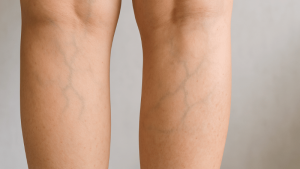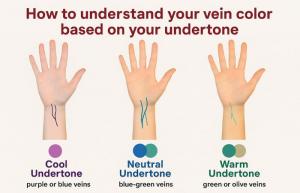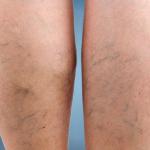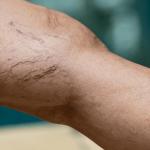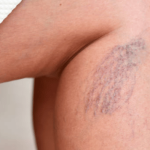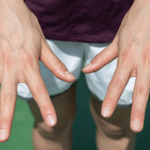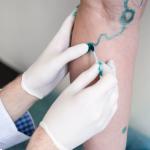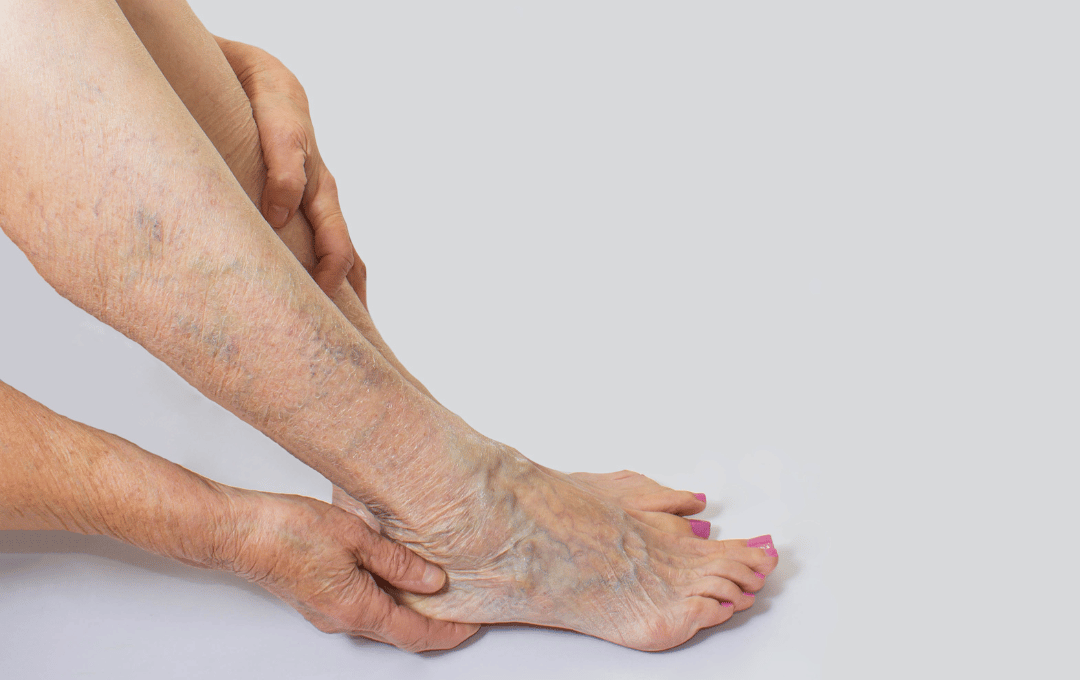
If you notice green veins on your legs, feet, hands, or other parts of your body, you might wonder if this is a cause for concern. Green veins generally have less to do with the color of your blood and more with how light interacts with your skin. Factors like skin tone, body composition, and even the lighting around you influence the color and visibility of your veins. However, if visible veins become more prominent in the legs, ankles, and feet and are accompanied by swelling, leg heaviness, or pain, it could be a sign of vein disease.
Do you wonder what causes veins to look green, what symptoms to watch for, and when to consult a specialist to maintain healthy veins?
What Do Green Veins Mean?
In most cases, green veins mean the undertones in your skin allow more green light to reflect when light hits the skin. When white light strikes, specific wavelengths are absorbed, while others are reflected back. Red light has a longer wavelength, so it penetrates deeper into the skin and surrounding tissue, making it more difficult for your eyes to detect when looking at superficial veins. Shorter wavelengths, like green and blue, reflect more easily from veins close to the skin’s surface, making these colors the ones you’ll see the best.
Veins are more likely to look blue or purple depending on how much oxygen is in your veins. Oxygen-rich blood is bright red, while oxygen-depleted blood is darker, resulting in blue or purple-colored veins.
Are Green Veins Good or Bad?
Green veins aren’t classified as good or bad and do not indicate a health concern on their own. However, green veins can sometimes signal an underlying issue when accompanied by aching or heavy legs, swelling, or bulging, twisted veins, as these symptoms may point to chronic venous insufficiency (CVI).
Chronic venous insufficiency (CVI) is a condition often linked to underlying vein disease, characterized by weakened or damaged valves in your leg veins. When this happens, the veins allow blood to flow backward and pool, rather than moving toward the heart. Over time, this condition can increase pressure in the veins, leading to swelling, discomfort, and more pronounced visibility of the veins. are a common symptom of CVI and often develop as the condition progresses.
Do Green Veins Mean I Have Varicose Veins?
Green veins do not always mean that you have varicose veins. Many people have healthy, green veins just beneath the skin’s surface that don’t bulge, twist, or cause discomfort, unlike varicose veins.
Are Green Veins a Sign of Poor Circulation?
Green veins by themselves are not a sign of poor circulation. The color often comes from light reflecting off your skin and veins. However, if you also notice symptoms such as cold hands or feet, numbness, tingling, swelling, or unusual fatigue, it may indicate vein disease.
If you’re unsure whether your green veins are healthy or may be a symptom of underlying vein disease, our symptom quiz can help you decide whether it’s time to see a vein specialist.
Take Our Vein Disease Symptoms Quiz
What Do Green Veins Look Like?
Green veins are most visible on the legs, hands, and arms, though their appearance varies depending on skin tone and fat distribution. The veins themselves can also appear differently depending on the health of the veins. For example, when veins are damaged from vein disease, they can appear as spider or varicose veins.
Spider veins are smaller, thinner veins closer to the skin’s surface, forming web-like patterns that are usually cosmetic. Varicose veins typically bulge from underneath the skin and are more likely to cause swelling, heaviness, or aching.
How Does Skin Tone Impact Green Veins?
Your skin color and its undertones significantly influence the color of your veins and their visibility. Lighter skin tones often make green veins more prominent because there’s less pigment to block light from passing through the skin. Darker skin tones tend to make veins appear darker or less visible, as increased pigment absorbs more light. Additionally, if your skin is thin or translucent, or if you have low body fat, your veins will likely be more visible, especially over bony areas such as the wrists or ankles.
Another factor that can impact the color and visibility of your veins is your skin’s undertones. Undertones are the subtle hues beneath your skin’s surface, and fall under three categories:
- Warm undertones (peachy, golden, or pink): Easier to see green veins.
- Cool undertones (violet, pink, or light blue): Easier to see blue or purple veins.
- Neutral undertones: Easier to see greenish-blue or bluish-purple veins.
Why Do My Veins Look Green in Certain Conditions?
Green veins can become more visible due to temporary changes in your body or environment. These shifts affect blood flow, skin thickness, and how light reflects off your veins, making them appear more prominent.
Some of these changes include:
- Heat: Veins dilate under heat, increasing blood flow and making veins more noticeable. Sun exposure and sunburns can also make veins more visible by damaging the collagen and other connective tissue in blood vessel walls.
- Exercise: Physical activity makes our veins more visible, but they usually appear less prominent after resting and drinking water.
- Hormonal Shifts: Pregnancy, menstruation, oral contraceptives, and certain thyroid conditions can cause hormone fluctuations that dilate small blood vessels, leading to more apparent veins. These hormonal changes can also weaken vein valves and walls over time, raising the risk of varicose veins.
- Aging and Thinner Skin: As we get older, our skin often becomes thinner, making it easier to see the veins underneath the skin.
How to Stop Green Veins From Becoming a Problem
Although green veins on their own aren’t typically a problem, maintaining healthy habits that support vein health is a great way to avoid future vein concerns. Lifestyle adjustments can help prevent vein disease from developing; however, these are not a substitute for proper vein treatment. Some of the lifestyle adjustments include:
- Staying active and maintaining a healthy weight keeps your blood flowing efficiently while minimizing the pressure and strain on your leg veins.
- Using compression stockings improves circulation, reduces swelling, and prevents blood from pooling in the legs.
- Protecting your skin from sun damage prevents it from weakening the tissues around the veins.
- Addressing circulation risks, such as prolonged sitting or standing, promptly to avoid vein strain.
When to See a Doctor About Green Veins
While green veins are often harmless, signs like skin discoloration, bulging or twisted veins, as well as any pain, swelling, or a heavy feeling in the legs, can signal a more serious condition. A vein screening can identify the cause and treat problems before they progress.
Vein specialists at USA Vein Clinics use state-of-the-art technology and imaging tests during our consultations to map veins and assess blood flow for an accurate diagnosis. Based on the diagnosis, our expert vein specialists will recommend the best treatment for your condition.
Take the Next Step Toward Healthier Veins
Worried about the green veins on your legs that are accompanied by symptoms like aching, swelling, or bulging veins? Schedule a consultation online today with USA Vein Clinics for personalized care at one of our nationwide locations.

